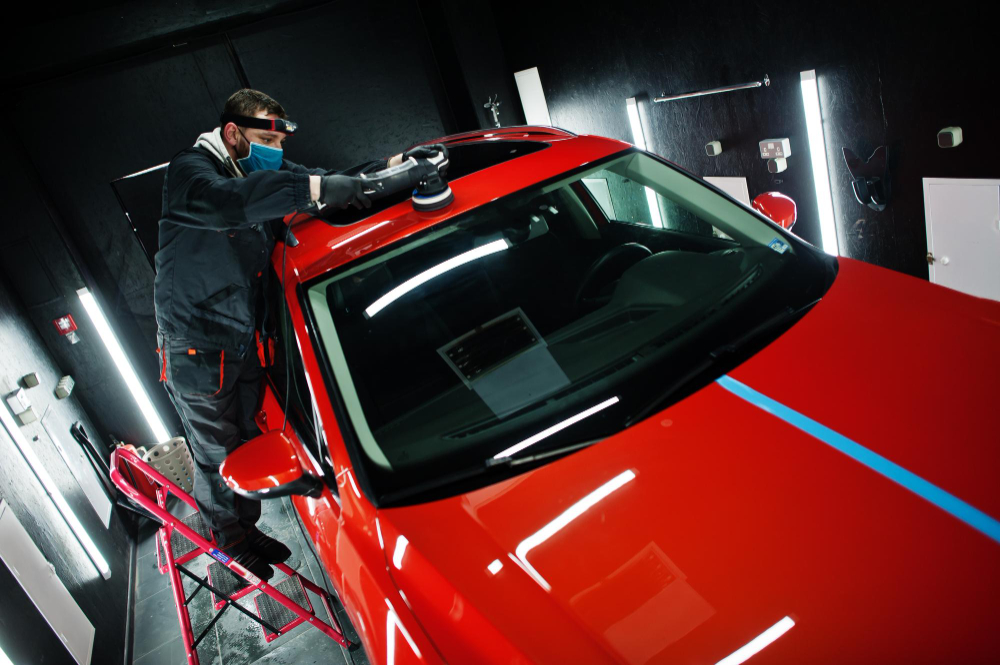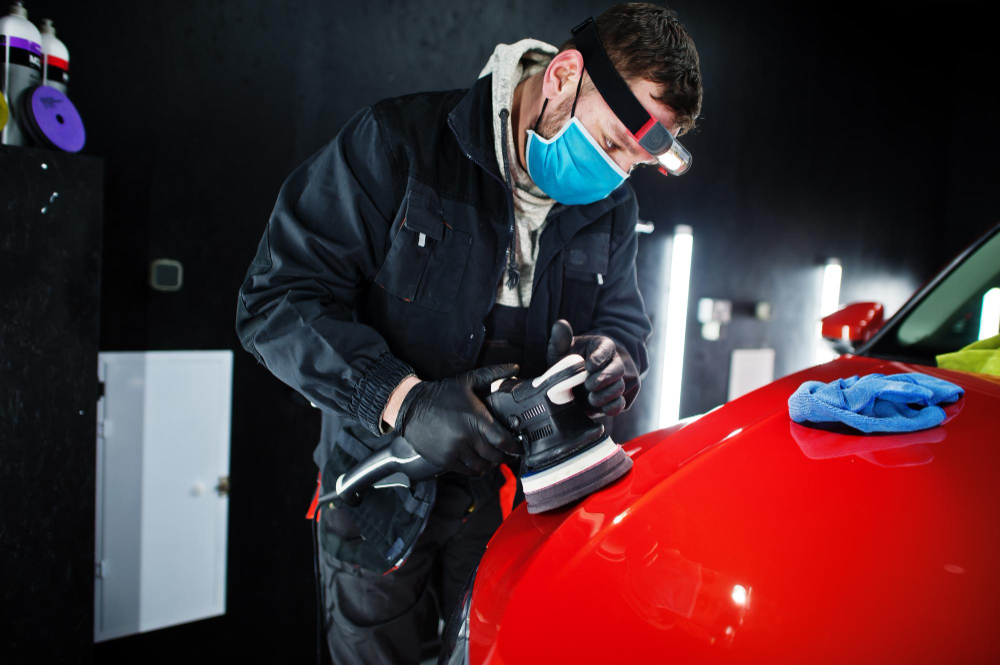Get the best reliable paint correction services in Jacksonville, FL. Restore your car’s glossy finish with expert correction and protection options.

Want your car to look like it just rolled out of a showroom—without actually buying a new one? That’s the magic of paint correction. If you’re in Jacksonville (or the Beaches), you’ve got a strong local option: a shop in Atlantic Beach that lists paint correction, ceramic coating, PPF, vinyl wrap, and PDR among its services—plus easy booking and a direct phone line.
Below is a clear guide to paint correction tailored for Jacksonville drivers: what it is, why our coastal climate makes it essential, how the process works, and how to choose a reliable paint correction service that’s worth your money.
What Is Paint Correction?
Paint correction is the careful, machine-polishing process that removes swirls, haze, light scratches, water spots, and oxidation from your clear coat—not just hiding them with wax. The goal: level the clear coat so light reflects evenly, restoring that deep, glossy, sharp reflection you see in car ads.
A quality correction typically involves:
- Decontamination: Removing bonded contaminants (tar, industrial fallout, brake dust).
- Defect removal: Measured compounding/polishing to remove swirls, light scratches, and oxidation.
- Refinement: Finishing polish that boosts clarity and depth.
- Inspection: Proper lighting to verify true correction (not filler).
- Protection: Sealing the result with ceramic coating or PPF (more on this below).
Think of it as precision skincare for your car: cleanse, exfoliate, treat, and protect.
Why Jacksonville, FL Drivers Need Paint Correction More Than Most
Jacksonville brings the heat, sun, salt air, and frequent beach runs. That cocktail is tough on paint.
- Intense UV & heat can fade and oxidize clear coats, dulling gloss over time.
- Coastal salt air accelerates oxidation and corrosion—especially around the Beaches and riverfront parking. Keeping the clear coat healthy (and protected) isn’t just cosmetic; it slows damage.
If your paint already shows spider-web swirls, chalkiness, or stubborn water spots, correction is the reset button. Seal it afterward and you’re far better equipped for Florida living.
Local Option: Direct Tint (Atlantic Beach) at a Glance
A local shop in Atlantic Beach, FL lists paint correction, ceramic coating, PPF, vinyl wraps, and paintless dent removal—with easy online booking and a published phone number. Their site also calls paint correction an essential prep step before ceramic coating or PPF (which detailers will tell you is best practice).
They also publish Jacksonville-focused posts (e.g., professional services for Jax drivers), and note that machine polishing can safely remove swirls and haze before coating. Translation: you correct first, then lock in gloss.
If you’re comparing long-term protection options after correction:
- Ceramic coating: a slick, hydrophobic shell that resists UV and grime and makes washing easier. The shop highlights ceramic services for Jacksonville/Atlantic Beach.
- PPF (Paint Protection Film): a self-healing clear film that protects against chips and scratches (think I-295 debris or A1A sand spray).
The Paint Correction Process (Step by Step)
Here’s what a reliable correction typically looks like so you know what to expect and what to ask for:
1) Intake & Inspection
A walk-around under strong, color-correct lighting to identify defects: swirls, wash marring, water spots, bird-drop etching, and random isolated deep scratches (RIDS). Expect a test spot to dial in the mildest combo that gets the job done (pad + compound/polish + machine speed).
2) Pre-Wash & Decontamination
- Citrus pre-wash/foam and a two-bucket wash to reduce marring.
- Iron remover and clay bar to pull out bonded contamination. This helps polish cut evenly and prevents dragging grit across the surface.
3) Taping & Protection of Trim
Masking sensitive edges, badges, rubber, and matte trim protects them from compound dust and pad strikes.
4) Correction (Cut) Stage
Targeted machine compounding removes the majority of swirls and defects. A dual-action polisher is standard; forced rotation or rotary may be used for heavier defects with care.
5) Polishing (Refinement) Stage
A finer polish and pad combo restores clarity and depth, reducing micro-marring left by compounding for that “liquid” finish.
6) Panel Wipe & Light Check
An IPS/IPA panel wipe removes any polishing oils so you can see true correction under inspection lights (no fillers).
7) Protection: Ceramic Coating or PPF
You’ve earned the gloss—lock it in:
- Ceramic coating bonds to the clear coat, adds slickness and UV resistance, and makes wash maintenance quick. Local shop pages emphasize ceramic services for Jacksonville and the Beaches.
- PPF adds physical impact resistance and self-healing for daily driving and highway miles.
8) Final Inspection & Aftercare Brief
Expect guidance on curing times, first washes, pH-neutral soaps, and safe wash methods to keep that fresh correction looking new.
Single-Stage vs. Multi-Stage: Which Do You Need?
- Single-Stage Polish: Great for newer vehicles with light wash marring. One refinement pass can noticeably boost gloss and “pop.”
- Two-Stage (Cut + Polish): The most common choice for daily drivers with visible swirls, water spots, and light oxidation.
- Multi-Stage/Spot Sanding: For darker paints or severe defects. Time-intensive but produces stunning, show-car clarity when done right.
A good shop will recommend the least aggressive approach that achieves your goals (and preserve clear coat thickness for the long term).
Signs You’re Due for Paint Correction
- Circular “spider web” swirls under sun or gas-station lights
- Hazy or dull reflections even after washing
- Water spots or etched bird droppings that don’t wash off
- Greyed, chalky look on horizontal panels (UV/heat exposure)
- You’re planning a ceramic coating or PPF and want the finish perfected first (the right sequence).
Paint Correction vs. “Just Polishing”
Polishing can temporarily mask defects with fillers. Correction removes a measured amount of clear coat to permanently level defects within safe limits. That’s why inspections and panel wipes matter—you want to see the true finish, not temporary gloss.
The Jacksonville Factor: Protecting Your Investment
Daily sun, mid-day parking, sea breeze, and weekend beach runs equal accelerated wear. Address those realities with a two-part plan:
- Correct the existing defects (swirls, oxidation, water spots).
- Protect against Florida with ceramic coating or PPF so you’re not re-correcting the car every year.
Florida’s UV and coastal air are relentless; UV breaks down clear coat and salty air speeds oxidation. Protection slows both, preserves your resell value, and keeps maintenance light and fast.

How to Choose a Reliable Paint Correction Service in Jacksonville
Use this checklist to separate pros from pretenders:
- Process Transparency: Can they explain their decon, test-spot, and inspection steps?
- Proper Lighting: Swirls hide under soft lighting. You want strong LED/scan lights for honest results.
- Clear Before/After Standards: Agree on targets (e.g., “remove swirls, minimize but not chase every RIDS on daily driver”).
- Protection Options On-Site: Ability to finish with ceramic coating and/or PPF so you don’t drive unprotected post-correction. The Atlantic Beach shop highlights both services locally.
- Reviews & Local Presence: Look for consistent reviews and easy contact/booking. The shop’s site links to Google reviews and displays its phone and booking button prominently.
- Aftercare Guidance: A reliable shop gives maintenance instructions so you keep that finish for years.
What Does It Cost—and How Long Does It Take?
It depends on:
- Vehicle size and paint condition
- Color (dark colors show more defects, often require more refinement)
- Desired outcome (enhancement vs. near-show finish)
- Add-ons (ceramic, PPF, windshield coatings, trim restoration)
Typical timelines range from half-day (light single-stage) to 1–2 days (two-stage with protection). For full front PPF or multi-stage corrections, plan accordingly. Your estimator should set expectations after a quick inspection and test spot.
Pairing Paint Correction With the Right Protection
Ceramic Coating (Daily Driver’s Best Friend)
- UV resistance + hydrophobicity for easy washing
- Cuts wash time and helps prevent new swirls when you use proper wash methods
- Great “cost-to-benefit” for city and highway driving around Duval and St. Johns
Local pages emphasize ceramic services available in Jacksonville/Atlantic Beach.
Paint Protection Film (Highway & Beach Warrior)
- Self-healing top coat masks light marring and resists chips
- Ideal for front bumpers, hoods, mirrors, rocker panels (A1A, JTB, I-95 life)
- Combine with ceramic on exposed but non-PPF panels for a best-of-both setup.
How to Keep Your Corrected Paint Looking New (Aftercare)
- Wait: Respect curing times if you added ceramic or film.
- Wash smart: pH-neutral soap, plush mitts, and the two-bucket method.
- Dry safely: Microfiber drying towel or touchless blower.
- Quick toppers: Use coating-safe detail sprays for that freshly detailed glow.
- Beat the sun: Shade parking when possible; rinse off salt spray after beach days.
Why This Shop Fits “Reliable Paint Correction Services in Jacksonville, FL”
- Local & accessible: Based in Atlantic Beach with a published number and “Book Now” button.
- Right sequence: They note paint correction as an essential prep step for ceramic coating or PPF—exactly how pros do it.
- Full protection stack: Ceramic coating options and PPF installation available in-house for a seamless, same-visit finish.
- Educates locally: Their Jacksonville-focused articles discuss professional services and the role of correction before coatings—useful reading if you like to research first.
FAQs About Paint Correction in Jacksonville
How long will paint correction last?
Months to years—it depends on your wash routine, parking habits, and whether you add ceramic or PPF. Protection dramatically extends the life of your corrected finish.
Can paint correction remove every scratch?
It removes many defects, but deep RIDS may be minimized rather than eliminated to preserve clear coat. A seasoned tech will explain what’s safely achievable.
Do I need ceramic coating if I get PPF?
They’re complementary. PPF guards against impacts; ceramic adds slickness/UV resistance and easier cleaning. Many owners ceramic-coat exposed panels and put PPF on high-impact areas.
Is paint correction safe for brand-new cars?
Yes. New cars often arrive with transport marring or dealership wash swirls. A light single-stage correction plus protection is common.
Ready to Restore Your Paint?
If you want reliable paint correction services in Jacksonville, FL, look for a shop that inspects under proper lighting, uses a test spot, explains the plan, and can protect the finish with ceramic or PPF immediately afterward. The Atlantic Beach shop mentioned above checks those boxes—and makes booking simple.
Contact details:
- Call: (904) 210-4161
- Address: 125 levy rd Atlantic Beach, FL 32233
- Website: directtint904.com

